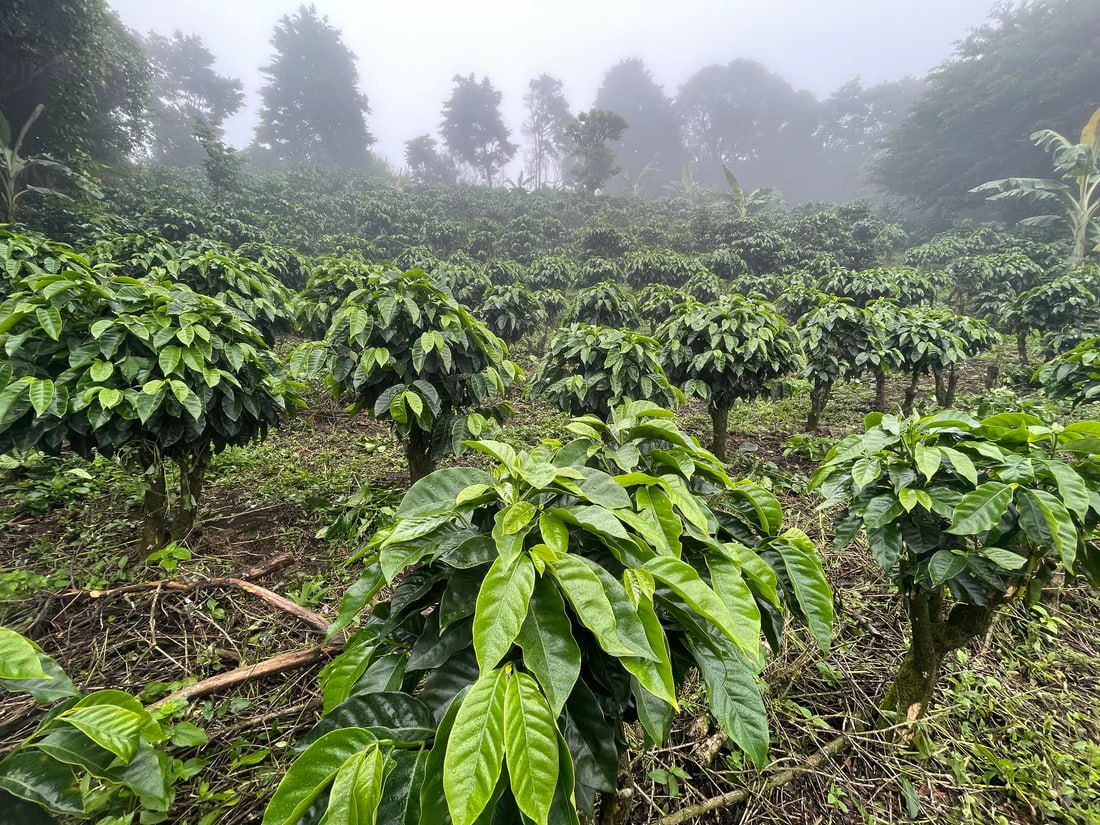ALL POSTS
ALL POSTS
Coffee Origins: Ethiopia
9 min read
Last edit: Jul 9, 2025

Ethiopia, the birthplace of arabica coffee, holds a unique position in the global coffee industry. With its rich history, diverse landscapes, and deep-rooted coffee culture, Ethiopia’s coffee is more than just a commodity. It’s a symbol of the nation’s heritage.
In this article we explore the origins of coffee in Ethiopia, the intricate nuances of its production, the various processing methods employed, the distinct coffee-producing regions within the country, and will try to make a prognosis on the future of the Ethiopian coffee industry.
History of Coffee in Ethiopia
The history of coffee in Ethiopia is captivating, steeped in legend and tradition.
The most popular tale traces the discovery of coffee back to a 9th-century goat herder named Kaldi. According to the NCA USA, Khaldi noticed that his goats became unusually energetic after eating the red berries from a certain tree. Intrigued, he tried the berries himself and experienced a similar surge of energy. Kaldi shared his discovery with a local monk, who used the berries to make a drink that helped him stay awake during long hours of prayer. This beverage soon spread among the monks and eventually beyond the borders of Ethiopia.
While this legend provides a colorful narrative, historical records suggest that coffee’s journey began in the Ethiopian region of Kaffa, from which the word “coffee” is believed to derive. The ancient Oromo people are thought to have been among the first to recognize the stimulating effects of coffee, initially consuming them crushed and mixed with animal fat as an energy-boosting snack.
By the 15th century, coffee had traveled from Ethiopia to Yemen, where it was cultivated and traded by Arab merchants, mainly inside the Ottoman Empire. The port city of Mocha became a major hub for coffee trade, and the beverage spread throughout the Arab world, eventually reaching Europe in the 17th century.
For a time, Ethiopia remained relatively isolated in its coffee consumption practices, preserving unique traditions. One can still find an opportunity to join a traditional coffee ceremony in Ethiopia, which is a ritual-like process of roasting, grinding, brewing and finally drinking fresh coffee.
Nuances of Coffee Production in Ethiopia
Ethiopia’s coffee production is characterized by its remarkable diversity, a result of the country’s varied terroir. Unlike many coffee-producing countries, Ethiopia’s coffee is predominantly grown on small family farms, often in forested or semi-forested areas. This method of cultivation, known as “garden coffee,” allows for a highly organic and sustainable production process, with minimal use of chemical fertilizers or pesticides. Grown in such conditions, coffee sherries can only be harvested by hand.
Most smallholder farms cannot process the cherries for the lack of resources and opt to sell the harvested coffee to processing plants and washing stations. Some farmers band together to form cooperatives which allows for better margins and higher level of control over the fermentation and drying. Cooperative lots can comprise a multitude of varieties from a list of farmers.
One of the most distinctive aspects of Ethiopian coffee production is the sheer diversity of coffee varieties. Ethiopia is home to hundreds of indigenous Arabica coffee varieties, known locally as “heirloom” varieties. These varieties have evolved naturally over centuries, resulting in a wide range of flavor profiles, from bright and fruity to deep and chocolaty. This genetic diversity is a key factor in Ethiopia’s reputation as a producer of some of the world’s finest and most complex coffees.
Ethiopia’s coffee is typically grown at high altitudes, ranging from 1000 to 2200 meters above sea level. The combination of altitude, climate, and soil conditions contributes to the development of beans with unique and intricate flavor characteristics.
Coffee Processing Methods in Ethiopia
The processing of coffee beans is a critical stage in the production chain, as it greatly influences the final flavor profile of the coffee. In Ethiopia, several traditional and modern processing methods can be found, each contributing to the diversity and complexity of Ethiopian coffee.
1. Natural Processing
The natural or dry processing method is one of the oldest and most traditional coffee processing techniques in Ethiopia. In this method, coffee cherries are harvested and then spread out on raised beds or patios to dry in the sun.
The cherries are turned regularly to ensure even drying and to prevent spoilage. Once the cherries are fully dried, the outer fruit layer is removed to reveal the coffee beans inside.
Natural processing impacts the flavor profile of the coffee, often resulting in a sweet, fruity, and full-bodied cup. The prolonged contact between the fruit pulp and the bean during drying allows for the transfer of fruit acids and other compounds, creating complex flavor notes. Ethiopian coffees processed using the natural method, such as those from the Harrar region, are known for their intense berry-like flavors and red wine-like acidity.
2. Washed Processing
The washed or wet processing method is another widely used technique in Ethiopia. In this method, coffee cherries are pulped to remove the outer skin and the pulp, the beans are then fermented in water to break down the remaining mucilage. After fermentation, the beans are thoroughly washed to remove any residual material and then dried on raised beds or patios.
Washed processing typically results in a cleaner, brighter, and more vibrant cup compared to natural processing. The fermentation process helps to develop acidity and clarity, highlighting the intrinsic flavors of the coffee bean. Coffees from regions like Yirgacheffe and Sidamo, which are often washed, are celebrated for their floral, citrusy, and tea-like characteristics.
3. Honey Processing
Relatively new technique originating from Costa Rica, honey processing, a method that lies between natural and washed processing, has gained popularity in recent years in Ethiopia. In this method, the coffee cherries are pulped, but instead of fermenting and washing the beans, they are dried with some of the mucilage still attached. The longer the beans with mucilage are dried the deeper the fermentation. The mucilage changes color, first to white, then to yellow, red and finally black.
Honey-processed coffees typically exhibit a balance of the fruity sweetness found in natural processed coffees and the acidity and clarity of washed coffees. While honey processing is less common in Ethiopia compared to natural and washed methods, it is gaining popularity both among farmers who are looking to experiment with new flavor profiles and consumers who are eager for new flavor experiences.
4. Experimental and Modern Practices
Processing techniques such as carbonic maceration, anaerobic fermentation and yeast inoculation are taking the market and Ethiopian farmers are not abstaining from the trend. With no universal standard among producers such coffee can very much differ from season to season.
New and experimental ways are now used by many coffee producers in Ethiopia yielding coffee with boozy, fermenty and tropical fruit-like profiles.
Such lots are still rare and not as easy to acquire as more traditionally processed ones.
Coffee Regions in Ethiopia
Ethiopia’s coffee-growing regions are as diverse as its coffee varieties, each with its own distinct terroir and cultural practices. These factors contribute to the wide range of flavor profiles found in Ethiopian coffee, making it a favorite among coffee lovers. The following are some of the most renowned coffee origins in Ethiopia.
1. Sidamo
Sidamo is one of Ethiopia’s most famous coffee regions, located in the southern part of the country. Coffees from Sidamo are known for their bright acidity, medium body, and complex flavor profiles, often presenting a citrus, berry, and floral profile. The high altitude and fertile soil in Sidamo provide ideal conditions for growing coffee, and both natural and washed processing methods are used here.
2. Yirgacheffe
Yirgacheffe, a sub-region within Sidamo, is synonymous with some of the most sought-after coffees in the world. Yirgacheffe coffees are typically washed and are celebrated for their exquisite floral aromas, tea-like body, and vibrant acidity. Common flavor notes include jasmine, bergamot, lemon, and tropical fruits. The high elevation and cool climate in Yirgacheffe contribute to the slow maturation of coffee cherries, resulting in complex and nuanced flavor profiles, perfect for filter coffee preparation.
3. Harrar
Located in the eastern part of Ethiopia, Harrar is one of the oldest coffee-growing regions in the country. Harrar coffees are primarily natural processed, giving them a distinctively bold and fruity flavor profile. These coffees are known for their winey acidity, heavy body, and notes of blueberry, blackberry, and chocolate. The arid climate and traditional sun-drying methods used in Harrar contribute to the region’s unique coffee characteristics.
4. Limu
The Limu region, situated in the western highlands of Ethiopia, produces coffees that are highly regarded for their balanced acidity, medium body, and sweet, fruity flavors. Limu coffees are usually washed, resulting in a clean cup with notes of citrus, stone fruit, and honey. The region’s rich volcanic soil and favorable growing conditions make it an ideal location for high-quality coffee production.
5. Jimma
Jimma, also located in western Ethiopia, is known for producing both washed and natural processed coffees. The flavor profile of Jimma coffees can vary widely depending on the processing method, but they often exhibit a rich, full-bodied taste with hints of fruit, spice, and earthy tones. Jimma has historically been associated with the production of “Djimmah,” a natural processed coffee with a distinctively wild and rustic flavor. Coffee from Jimma region is a favorite pic of many roasters for blending with more mildly tasting coffees.
6. Gesha
The Gesha region, near the town of Gesha in southwestern Ethiopia, is the original home of the Gesha variety (also known as Geisha), which has gained international fame for its exceptional quality. Gesha coffees are often characterized by their intense floral aroma, bright acidity, and complex flavor profile, with notes of jasmine, bergamot, tropical fruit, and tea. The Gesha Village Coffee Estate has played a pivotal role in bringing this variety to the global stage, using meticulous cultivation and processing techniques to produce some of the world’s most sought-after coffees.
Prognosis on the Future of the Ethiopian Coffee Industry
Ethiopia’s coffee industry is at a crossroads, facing both significant opportunities and challenges as it looks to the future. The global demand for high-quality, specialty coffee continues to rise, and Ethiopia’s reputation as a producer of some of the finest coffees in the world positions it well to capitalize on this trend. However, several factors will determine the trajectory of the Ethiopian coffee industry in the coming years. As TraceX points out, Ethiopian smallholder coffee producers are faced with challenges that cannot be easily overcome.
1. Struggle for Sustainability
Climate change poses a serious threat to coffee production worldwide, and Ethiopia is no exception. Rising temperatures, erratic rains, and the increased prevalence of pests and diseases are all challenges that Ethiopian coffee producers must contend with. To safeguard the future of the industry, there is a growing need for sustainable farming practices, including the development of climate-resilient coffee varieties and the adoption of agroforestry techniques. Ethiopia’s rich biodiversity and genetic coffee heritage offer potential solutions, but significant investment and support are required to implement these strategies on a large scale.
2. Economic and Social Challenges
The Ethiopian coffee industry is deeply rooted in smallholder farming, with millions of families relying on coffee cultivation for their livelihoods. Ensuring fair prices for farmers and improving access to resources, such as credit, training, and infrastructure, are essential for the long-term sustainability of the industry. Initiatives such as Fair Trade and direct trade relationships between Ethiopian farmers and international buyers have the potential to provide more equitable economic benefits, but these must be scaled up to reach a larger number of producers.
Conclusion
Ethiopia’s coffee industry is among the few that provide high-quality coffee, including specialty coffee, every season. With unique and beautiful fruity and floral profiles, Ethiopian coffee remains a favorite of many professionals and consumers globally.
So next time in a coffee shop do look up a bag of coffee from Ethiopia, chances are it will become your favorite too.
Would you like to learn more about other coffee roasters in Slovenia? Here are the guides.








